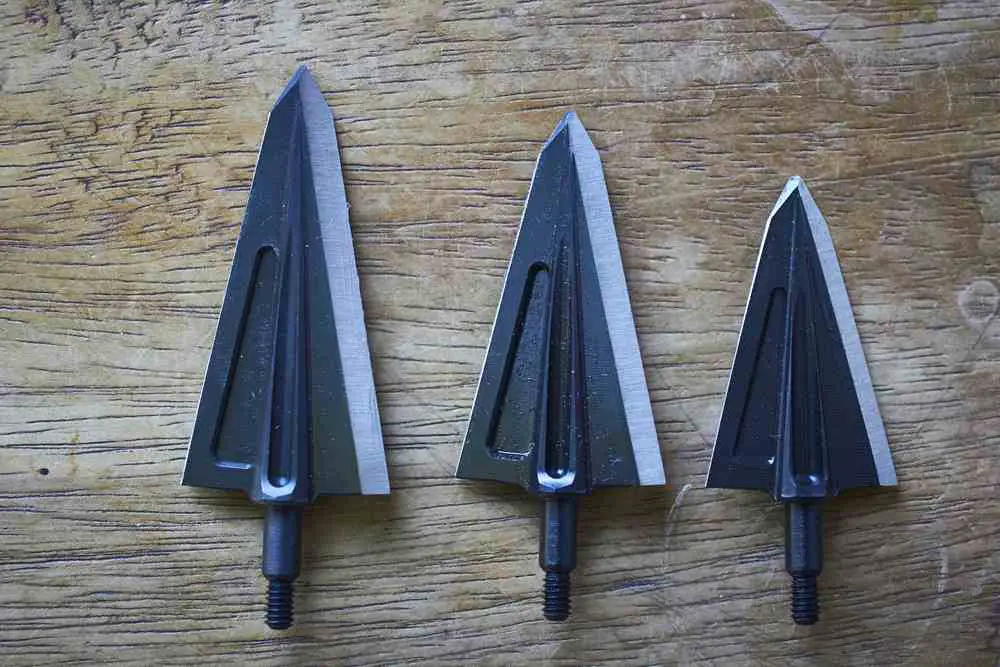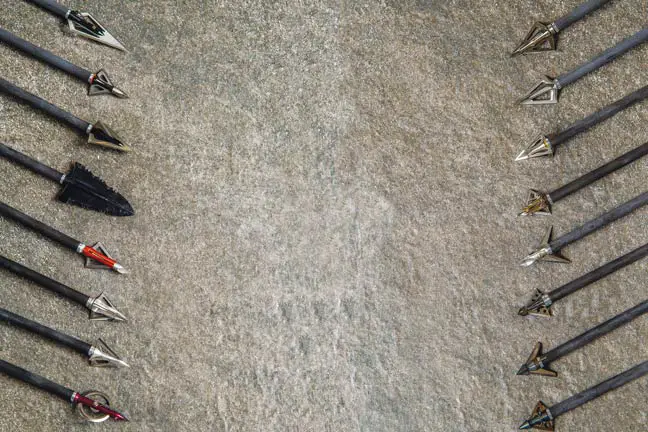Struggling to choose the perfect grain weight for your Broadhead? Well, not anymore.
If you’ve questions like “what grain broadhead should I use and why”? We share your concern.
Choosing broadheads can be a head-scratcher for anyone who doesn’t know their specifics, especially regarding the grain.
It’s a normal dilemma to have and one I hope to assist you in solving today.
Don’t worry. It’s actually quite simple and largely preference-based. There are a few key things to keep in mind, which I will highlight below.
This guide will discuss grain, types, and other considerations you’ll need to consider while choosing the perfect broadhead for your next hunting mission.
Let’s explore how to choose broadhead grains for different purposes!
What Grain Broadhead Should I Use in Hunting?
So, how to know what grain broadhead to use? Well, it’s a bit complicated. Let’s put it like this.
Suppose we wanted to be super specific to the point of being finicky.
In that case, we could say the grain weight choice depends on varying factors such as the game being hunted, the bow poundage, arrow weight, field tip grain, shooting distance, and more.
However, the vast majority of bowhunters stick to 100-grain broadheads. It’s the best broadhead for deer and most other typical games.
It’s right in the middle of the performance scale. It offers the most balance for all common scenarios, uber-large game hunting aside.
This is a good reason that Most companies that manufacture broadheads do so mainly for 100 grain.
Some offer 125-grain broadheads all the way up to 300-grain, but they are low in number.
The thing about broadhead grain is that if it’s too heavy, it becomes counter-productive.
Nowadays, most arrows are carbon arrows and go well in a weight ratio of 100 grains. 100 is also enough to bring down a fairly large game.
You’d need something heavier for, let’s say, an elephant, but who here are bow hunting elephants on a regular basis?
Truth be told, you can tune your bow and arrows to correctly handle anything up to 300 grain, but it’s an unnecessary headache that significantly limits the options of available broadhead types and styles you can choose from.
Things to Consider When Choosing a Broadhead

1. Type
Fixed blade broadheads:
These broadheads are one-piece, solid arrowheads. There are no moving or replaceable parts.
It’s probably the oldest and most traditional style of broadhead there is. Fixed blade broadheads are strong, durable, proven to be effective, and cheaper in comparison to others.
Mechanical broadheads:
These broadheads feature a set of blades that are hidden during arrow flight and pop out on impact.
They offer the widest diameter of the broadhead options. These are relatively new and modern addition to the world of bowhunting.
The existence of moving parts on rare occasions lends itself to complications. Still, limited surface area on the arrow tip means better accuracy and less pesky deviation due to wind, especially at high arrow velocity and over longer distances.
Replaceable blade broadheads:
This type is a member of the fixed family in the sense that there’s nothing mechanical about the broadhead.
The blades, however, are replaceable instead of permanently fixed.
This allows for quick and easy blade replacements for those who don’t favor sharpening broadheads constantly or replacing their fixed broadheads entirely when a blade becomes irreparable.
2. Weight
If you’re having questions like, what weight broadhead should i use, this section is for you!
When choosing a broadhead, it is imperative to consider the weight and grain.
The grain needs to match the weight of your field tip. Also, the overall weight needs to be balanced for the conditions to which you’re exposing the broadhead.
Too much weight with too little poundage and vice versa can become a big problem.
An unbalance here can cause a mediocre penetration, serious deviation, a damaged arrow, or a wound that doesn’t bleed enough to leave a decent tail for tracking.
Match your grain to the grain of your field tip. The rest is intuitive logic and some trial and error.
Test fires will set you straight in the weight department if you have any doubts.
3. Blade count
The number of blades you want on your broadhead is also something to consider.
You get standard two-blade broadheads, tri-blade, four-blade, and even six-blade broadheads. The number of blades your head has will determine the kind of cut you make on the animal.
The more blades and edges, the more cutting and tearing, and the more blood to follow.
That’s not to say you should automatically choose six-blade heads, though.
You can punch a really good through-and-through using a simple two-bladed broadhead. It all depends on your preference and your shooting style.
Keep in mind, though, that the more blades you have, the more energy you need to force them all through the animal hide.
So if you’re keen to sport six-bladers, I suggest a minimum of 60 lbs as your bow weight.
4. Accuracy
Accuracy is, of course, non-negotiable when hunting. No one wants to waste time wading through the thicket in search of the three arrows that didn’t hit the mark.
As a general rule, mechanical broadheads are more accurate at high speeds and over long distances as they catch less wind.
The difference will barely be noticed if shooting close-range with medium to low poundage, though.
Many people swear by the extreme difference in accuracy with mechanical broadheads and will claim they are the best broadhead type.
However, plenty of bowhunters made deadly shots from far off with a standard fixed broadhead.
5. Penetration
Penetration is another obvious need when hunting. Imagine hitting your mark exactly where you were aiming and watching in utter dismay as it bounces off.
Different broadheads offer different penetration values and conditions, so you’ll need to be sure it suits what’s relevant to you.
Mechanical broadheads with a wide diameter offer bigger holes but require higher poundage to ensure adequate penetration. Smaller fixed broadheads with only two blades will offer easier penetration with any poundage.
But if the poundage is too high, the rip-through will be so clean that the animal barely leaves a blood trail.
You get broadheads explicitly designed for superior penetration, such as cut-on-contact broadheads. That can increase your chance by a lot.
However, you’ll need to make sure that your bow, arrow weight, firing distance, and animal match the broadhead’s capabilities and limitations.
6. Cutting Diameter
Cutting diameter is simply how big the hole in the animal will be.
All broadhead types are offered in at least three different diameter ranges, with mechanical broadheads generally offering the widest.
Keep in mind, though, again, you need more energy (poundage) to push more diameter through an animal.
You also have to weigh what’s more important to you between one big hole and a through-and-through that is essentially two smaller holes. Most hunters agree a better blood trail is created by two holes.
Getting a wide-diameter broadhead through both sides of an animal can be quite challenging. But ultimately, it’s up to your preference.
7. Dependability
Dependability is also a big factor to consider. You want to be able to trust your arrow to do what it should consistently without failing.
With enough tuning and tweaking, you can get almost any broadhead to function dependably. Still, it is generally accepted that one-piece fixed-blade broadheads are the most dependable overall.
Also, a bow can’t be called dependable if it’s not useable. The limit of how much poundage a bow can legally have varies from state to state. Check your local regulations before you go out on the field.
Broadhead Tuning Tips
If your bow has been properly tuned and your arrows are well-fletched, you’ll need to ensure your broadheads are tuned too.
If not, they will spin wrong in flight and cause deviation.
The most common problem with every type of broadhead that requires tuning is how well it’s set on the arrow to insert.
If it is not set well, it shakes during mid-flight spin, which pulls the arrow off course and your frustration to the max real quick.
To see if the broadhead is set right, hold the arrow against a sheet of paper lightly and spin it.
If the indent is a simple point, you’re golden. If it’s a circle or something similar, it needs tuning!
To do this, simply apply pressure to the arrow while the broadhead is against a surface.
Give it a good nudge, so it goes all the way into the center. Check on the paper if this has worked.
If not, repeat the process a few times. If it still fails, remove the broadhead from the arrow and put it back on.
There are many factors to consider when choosing the best broadheads, but remember that a skilled archer can make any broadhead work.
It’s largely preference based. Bows, arrows, and broadheads can all be tuned and adjusted to give you what you want from your shot.
I hope things are clearer now and that the information in this guide has helped you decide on the perfect broadhead for your hunting missions.
Thanks for reading this far. Happy hunting to you!
FAQs
Which Is Better: 100-Grain Or 125 Grain Broadheads?
125-grain broadheads provide slightly better performance than 100-grain broadheads in almost every way. The most common choice is 100-grain, but if your bow can handle the poundage, the opportunity is definitely worth considering.
What Broadhead Is Best For Deer?
If you’re exploring to learn what size broadhead for deers, a 125-grain broadhead will work the best. When it comes to the type of broadhead, both mechanical and fixed-blade broadheads can work well.
Are Heavier Broadheads More Accurate?
Not necessarily. You can even get better results with lighter broadheads if you have great Front of Center (FOC). You’ll need to tune your arrows to get the best FOC possible.
How Do You Adjust Broadheads?
When target practicing, pay attention to the group you’re hitting. If the group hits the right of the field point, move your arrow rest slightly (1?64 or 1?32-inch) to the left. If the group hit left, move the arrow rest to the right. The same goes for vertical adjustment.









Leave a Comment